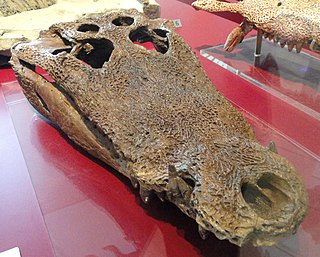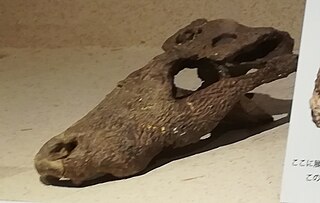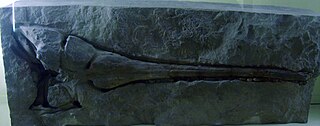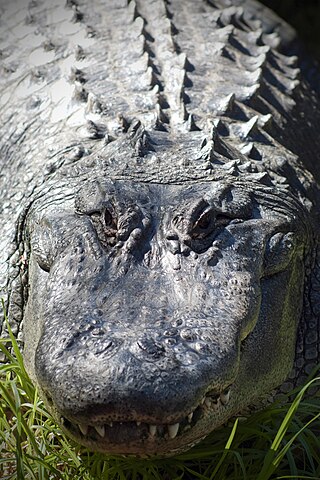
Deinosuchus is an extinct genus of alligatoroid crocodilian, related to modern alligators and caimans, that lived 82 to 73 million years ago (Ma), during the late Cretaceous period. The name translates as "terrible crocodile" and is derived from the Greek deinos (δεινός), "terrible", and soukhos (σοῦχος), "crocodile". The first remains were discovered in North Carolina in the 1850s; the genus was named and described in 1909. Additional fragments were discovered in the 1940s and were later incorporated into an influential, though inaccurate, skull reconstruction at the American Museum of Natural History. Knowledge of Deinosuchus remains incomplete, but better cranial material found in recent years has expanded scientific understanding of this massive predator.

Diplocynodon is an extinct genus of alligatoroid crocodilian that lived during the Paleocene to Middle Miocene in Europe. Some species may have reached lengths of 3 metres (9.8 ft), while others probably did not exceed 1 metre (3.3 ft). They are almost exclusively found in freshwater environments. The various species are thought to have been opportunistic aquatic predators.

Borealosuchus is an extinct genus of crocodyliforms that lived from the Late Cretaceous to the Eocene in North America. It was named by Christopher Brochu in 1997 for several species that had been assigned to Leidyosuchus. The species assigned to it are: B. sternbergii, the type species, from the Maastrichtian of Colorado, Montana, North Dakota, South Dakota, and Wyoming; B. acutidentatus, from the Paleocene of Saskatchewan; B. formidabilis, from the Paleocene of North Dakota; B. griffithi, from the Paleocene of Alberta; and B. wilsoni, from the Eocene of Wyoming. B. formidabilis is particularly well-known, represented by the remains of many individuals from the Wannagan Creek site in North Dakota.

Leidyosuchus is an extinct genus of alligatoroid from the Late Cretaceous of Alberta. It was named in 1907 by Lawrence Lambe, and the type species is L. canadensis. It is known from a number of specimens from the middle Campanian age Dinosaur Park Formation. It was a medium-sized alligatorid, with a maximum skull length greater than 40 centimeters (16 in).

Hassiacosuchus is an extinct genus of small alligatorid from the early Eocene of Germany, found at the Messel pit. It was named in 1935 by K. Weitzel, and the type species is H. haupti. A second species, H. kayi, was named in 1941 by C.C. Mook for material from the Bridgerian of Wyoming, but was reassigned to Procaimanoidea in 1967 by Wassersug and Hecht. Hassiacosuchus may be the same as Allognathosuchus; Christopher Brochu has recommended continuing to use Hassiacosuchus.

Libycosuchus is an extinct genus of North African crocodyliform possibly related to Notosuchus; it is part of the monotypic Libycosuchidae and Libycosuchinae. It was terrestrial, living approximately 95 million years ago in the Cenomanian stage of the Late Cretaceous. Fossil remains have been found in the Bahariya Formation in Egypt, making it contemporaneous with the crocodilian Stomatosuchus, and dinosaurs, including Spinosaurus. It was one of the few fossils discovered by Ernst Stromer that wasn't destroyed by the Royal Air Force during the bombing of Munich in 1944. The type species, L. brevirostis, was named in 1914 and described in 1915.

Alligatoroidea is one of three superfamilies of crocodylians, the other two being Crocodyloidea and Gavialoidea. Alligatoroidea evolved in the Late Cretaceous period, and consists of the alligators and caimans, as well as extinct members more closely related to the alligators than the two other groups.

Necrosuchus is an extinct genus of caiman from modern day Argentina that lived during the Paleocene epoch. It inhabited the fluvio-lacustrine environment of the Patagonian Salamanca Formation.

Allognathosuchus is an extinct genus of alligatorine crocodylian with a complicated taxonomic history. It was named in 1921.

Navajosuchus is an extinct genus of alligatorine crocodylian. Its fossils have been found in the Paleocene-age Nacimiento Formation of the San Juan Basin, New Mexico. It was named in 1942 by Charles C. Mook, and the original type species was N. novomexicanus. N. novomexicanus was based on AMNH 5186, a partial skull collected in 1913. Later research showed that Navajosuchus novomexicanus was the same as the earlier-named Allognathosuchus mooki. However, A. mooki does not belong to the genus Allognathosuchus, and so the name of the crocodilian becomes Navajosuchus mooki. Under whichever name is used, this animal would have been a generalized predator of the Nacimiento floodplains. It was the most common Nacimiento Formation crocodilian, found in both the Puercan and Torrejonian faunal assemblages.

Asiatosuchus is an extinct genus of crocodyloid crocodilians that lived in Eurasia during the Paleogene. Many Paleogene crocodilians from Europe and Asia have been attributed to Asiatosuchus since the genus was named in 1940. These species have a generalized crocodilian morphology typified by flat, triangular skulls. The feature that traditionally united these species under the genus Asiatosuchus is a broad connection or symphysis between the two halves of the lower jaw. Recent studies of the evolutionary relationships of early crocodilians along with closer examinations of the morphology of fossil specimens suggest that only the first named species of Asiatosuchus, A. grangeri from the Eocene of Mongolia, belongs in the genus. Most species are now regarded as nomina dubia or "dubious names", meaning that their type specimens lack the unique anatomical features necessary to justify their classification as distinct species. Other species such as "A." germanicus and "A." depressifrons are still considered valid species, but they do not form an evolutionary grouping with A. grangeri that would warrant them being placed together in the genus Asiatosuchus.

Dinosuchus is a genus of extinct alligatorid crocodilian. It was very large compared to other alligatorids, save for the giant caiman Purussaurus and its closest relatives. The genus was first described in 1876 on the basis of a vertebra from the Brazilian Amazon, the type species being named D. terror. In 1921, a new species of Dinosuchus, D. neivensis, was named based on a large mandible that was discovered in Colombia. D. neivensis was later found to be synonymous with both Brachygnathosuchus braziliensis and Purussaurus brasiliensis, being reassigned in 1924 to the senior synonym P. brasiliensis. In 1965, D. terror was proposed to be a nomen vanum. In 1936, Robert Broom used the name Dinosuchus for a dinocephalian therapsid from South Africa. Broom's Dinosuchus is now considered a junior synonym of Anteosaurus.

Kentisuchus is an extinct genus of gavialoid crocodylian, traditionally regarded as a member of the subfamily Tomistominae. Fossils have been found from England and France that date back to the early Eocene. The genus has also been recorded from Ukraine, but it unclear whether specimens from Ukraine are referable to Kentisuchus.

Musturzabalsuchus is an extinct monospecific genus of allodaposuchid eusuchian crocodyliform. The type and only species is Musturzabalsuchus buffetauti.
Orthogenysuchus is an extinct genus of caimanine alligatorids. Fossils have been found from the Wasatch Beds of the Willwood Formation of Wyoming, deposited during the early Eocene. The type species is O. olseni. The holotype, known as AMNH 5178, is the only known specimen belonging to the genus and consists of a skull lacking the lower jaws. The braincase is filled in by the matrix and most of the suture lines between bones are indiscernible, making comparisons with other eusuchian material difficult.

Pholidosaurus is an extinct genus of neosuchian crocodylomorph. It is the type genus of the family Pholidosauridae. Fossils have been found in northwestern Germany. The genus is known to have existed during the Berriasian-Albian stages of the Early Cretaceous. Fossil material found from the Annero and Jydegård Formations in Skåne, Sweden and on the island of Bornholm, Denmark, have been referred to as a mesoeucrocodylian, and possibly represent the genus Pholidosaurus.
Prodiplocynodon is an extinct genus of basal crocodyloid crocodylian. It is one of the only crocodyloids known from the Cretaceous and existed during the Maastrichtian stage. The only species of Prodiplocynodon is the type species P. langi from the Lance Formation of Wyoming, known only from a single holotype skull lacking the lower jaw.

Brevirostres is a paraphyletic group of crocodilians that included alligatoroids and crocodyloids. Brevirostres are crocodilians with small snouts, and are distinguished from the long-snouted gharials. It is defined phylogenetically as the last common ancestor of Alligator mississippiensis and Crocodylus niloticus and all of its descendants. This classification was based on morphological studies primarily focused on analyzing skeletal traits of living and extinct fossil species, and placed the gharials outside the group due to their unique skull structure, and can be shown in the simplified cladogram below:

"Crocodylus" affinis is an extinct species of crocodyloid from the Eocene of Wyoming. Fossils were first described from the Bridger Formation by American paleontologist Othniel Charles Marsh in 1871. Marsh described the species, along with every other species of crocodyloid in the Bridger Formation, under the genus Crocodylus. The known specimen of "Crocodylus" affinis is a skull found at Grizzly Buttes, Wyoming, measuring 13 inches in length on the upper surface. Recent phylogenetic studies of crocodyloids show that "C." affinis is not a species of Crocodylus, but a genus has not yet been erected to include the species. Other Bridger species such as Crocodylus clavis and Brachyuranochampsa zangerli have been synonymized with "C." affinis.

Allodaposuchidae is an extinct clade of eusuchians that lived in Europe during the Late Cretaceous (Santonian-Maastrichtian).




















